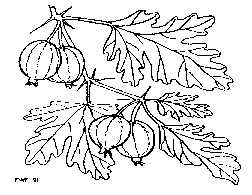 Today, August 7th …
Today, August 7th …Dorothy Wordsworth, sister of the poet William Wordsworth, clearly had a writer’s inclinations herself. It appears however, that she had no inclination for publication, preferring (or allowing) that fame for her brother, and to that end she devoted herself to the domestic chores of the household she shared with him in England’s Lake District. Her writing shines in her journals, and in amongst her lyrical descriptions of the surrounding countryside, she recorded the homely household chores such as the cooking.
On this day in late summer in 1800 she wrote:
“Thursday Morning….Boiled gooseberries – N.B, 2 lbs of sugar in the first panfull, 3 quarts all good measure – 3lbs in the 2nd 4 quarts – 21/2 lb in the 3rd.”
Etymologists disagree over the origin of the word “gooseberry”. Is it a corruption of an old German name (krausbeere) or old French name (groseille)? Or is it something to do with the goose? The OED refuses to commit on this, saying “The grounds on which plants and fruits have received names associating them with animals are so commonly inexplicable, that the want of appropriateness in the meaning affords no sufficient ground for assuming that the word is an etymologizing corruption.”
Dorothy almost certainly used her gooseberries in pies, but they have had a wide range of culinary uses over the centuries. Thankfully, in spite of their being no evidence at all for an etymological connection with the goose, there is a culinary connection – perhaps this IS the connection!. Gooseberry sauce was a common accompaniment to fish such as mackeral, but it was also used with goose, as in the following recipe from “The queen’s royal cookery: or, expert and ready ways for the dressing of all sorts of flesh, fowl, fish: …” by T.Hall, free cook of London (1709).
Sauce for Green-Geese.
Take Sorrel, pick it and wash it, and swing it in a coarse Cloth and stamp it, and strain the Juice; then have some Gooseberries tender scalded, but not broke; then melt some Butter very thick with the Juice of Sorrel; then sweeten it well with Sugar, and put in the Gooseberries, put it into the Dish, and lay the Geese upon it; and garnish the Dish with scalded Gooseberries and a little scrap’d Sugar; this Sauce will serve for a boiled Leg of Lamb.
There is something satisfying about the idea of green gooseberry sauce for a green goose, is there not? (“green” in this case, meaning young and fresh, not mouldy or putrefying!)
On this Topic …
According to the OED, the phrase “Gooseberry wine” can mean “an inferior or spurious champagne”, but it can mean the real thing too, and the real thing was said to taste like “English Frontiniac”, which was surely made from the variety called “Champain Gooseberry”?
There are recipes for Gooseberry Wine in Hannah Glasse (1747) and Mrs. Dalgairns (1840) on the Companion to The Old Foodie site.
A "Good Gooseberry Tart" appeared in the story of June 8th 2006
Tomorrow: Nella's Orange Jelly.
Quotation for the Day …
Give me books, French wine, fruit, fine weather and a little music out of doors, played by somebody I do not know. Keats.
No comments:
Post a Comment